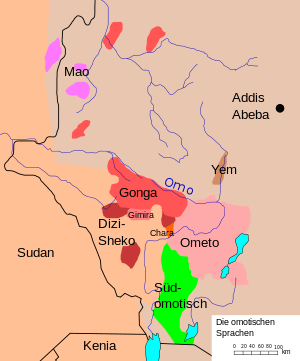Omotic languages
| Omotic | |||||
|---|---|---|---|---|---|
| Geographic distribution: | Ethiopia | ||||
| Linguistic classification: |
| ||||
| Subdivisions: |
| ||||
| ISO 639-5: | omv | ||||
| Glottolog: | None | ||||
|
The Omotic languages
Neighboring languages
| |||||
The Omotic languages are a branch of the Afroasiatic family spoken in southwestern Ethiopia. The Ge'ez script is used to write some Omotic languages, the Latin alphabet some others. They are fairly agglutinative and have complex tonal systems (see Bench language, for example).
Languages
The North and South Omotic branches ("Nomotic" and "Somotic") are universally recognized. The primary debate is over the placement of the Mao languages. Bender (2000) classifies Omotic languages as follows:
- South Omotic / Aroid (Hamer-Banna, Aari, Dime, Karo)
- North Omotic / Non-Aroid
Apart from terminology, this differs from Fleming (1976) in including the Mao languages, whose affiliation had originally been controversial, and in abolishing the "Gimojan" group. There are also differences in the subclassification of Ometo, which is not covered here.
Hayward (2003) separates out the Mao languages as a third branch of Omotic, and breaks up Ometo–Gimira:
Blench (2006) gives a more agnostic classification:[1]
Bosha† is unclassified; Ethnologue lists it as a dialect of Kafa, but notes it may be a distinct language.
Classification
Omotic is generally considered the most divergent branch of the Afroasiatic languages. Greenberg (1963) had classified it as the Western branch of Cushitic. Fleming (1969) argued that it should instead be classified as an independent branch of Afroasiatic, a view which Bender (1971) established to most linguists' satisfaction,[2] though a few linguists maintain the West Cushitic position,[3] or that only South Omotic forms a separate branch, with North Omotic remaining part of Cushitic. Blench (2006) notes that Omotic shares honey-related vocabulary with the rest of Afroasiatic, but not cattle-related vocabulary, suggesting that the split occurred before the advent of pastoralism. A few scholars have raised doubts that the Omotic languages are part of the Afroasiatic language family at all,[4][5] and Theil (2006) proposes that Omotic be treated as an independent family.[6] However, the general consensus, based primarily on morphological evidence, is that membership in Afroasiatic is well established.[7]
See also
Notes
- ↑ Blench, 2006. The Afro-Asiatic Languages: Classification and Reference List
- ↑ Hayward (2000:85)
- ↑ Lamberti (1991), Zaborksi (1986)
- ↑ I. M. Diakonoff (1998) Journal of Semitic Studies 43:209: "It is quite evident that cultural ties between Proto-Semitic and the African branches of the Afrasian macrofamily must have been severed at a very early date indeed. However, the grammatical structure of [Common Semitic] (especially in the verb) is obviously close to that of Common Berbero-Libyan (CBL), as well as to Bedauye. (Bedauye might, quite possibly, be classified as a family distinct from the rest of Kushitic.) The same grammatical isoglosses are somewhat more feebly felt between Semitic and (the other?) Kushitic languages. They practically disappear between the Semitic and the Omotic languages, which were formerly termed Western Kushitic, but which actually may not be Afrasian at all, like their neighbours the Nubian languages and Meroitic."
- ↑ Newman (1980)
- ↑ Rolf Theil (2006) Is Omotic Afro-Asiatic? pp 1–2: "I claim to show that no convincing arguments have been presented [for the inclusion of Omotic (OM) in Afro-Asiatic (AA)], and that OM should be regarded as an independent language family. No closer genetic relations have been demonstrated between OM and AA than between OM and any other language family."
- ↑ Gerrit Dimmendaal (2008) "Language Ecology and Linguistic Diversity on the African Continent", in Language and Linguistics Compass 2/5:841: "Although its Afroasiatic affiliation has been disputed, the allocation of Omotic within this family is now well-established, based on the attestation of morphological properties that this family shares with other Afroasiatic branches."
Sources cited
- Bender, M. Lionel. 2000. Comparative Morphology of the Omotic Languages. Munich: LINCOM.
- Fleming, Harold. 1976. Omotic overview. In The Non-Semitic Languages of Ethiopia, ed. by M. Lionel Bender, pp. 299–323. East Lansing, MI: Michigan State University.
- Newman, Paul. 1980. The classification of Chadic within Afroasiatic. Universitaire Pers Leiden.
General Omotic bibliography
- Bender, M. L. 1975. Omotic: a new Afroasiatic language family. (University Museum Series, 3.) Carbondale, IL: Southern Illinois University.
- Blench, Roger. 2006. Archaeology, Language, and the African Past. AltaMira Press
- Hayward, Richard J., ed. 1990. Omotic Language Studies. London: School of Oriental and African Studies.
- Hayward, Richard J. 2003. Omotic: the "empty quarter" of Afroasiatic linguistics. In Research in Afroasiatic Grammar II: selected papers from the fifth conference on Afroasiatic languages, Paris 2000, ed. by Jacqueline Lecarme, pp. 241–261. Amsterdam: John Benjamins.
- Lamberti, Marcello. 1991. Cushitic and its classification.'Anthropos 86(4/6):552-561.
- Zaborski, Andrzej. 1986. Can Omotic be reclassified as West Cushitic? In Gideon Goldenberg, ed., Ethiopian Studies: Proceedings of the 6th International Conference pp. 525–530. Rotterdam: Balkema.
External links
- Is Omotic Afro-Asiatic? by Rolf Theil
